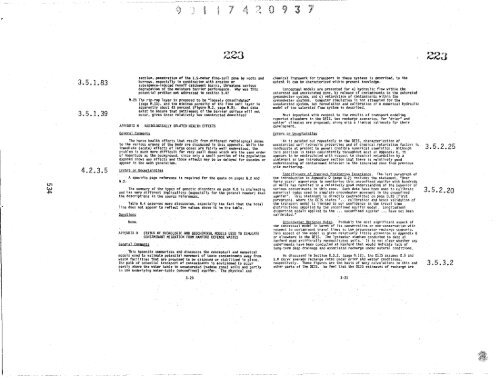EIS-0113_Section_11 - Hanford Site
EIS-0113_Section_11 - Hanford Site
EIS-0113_Section_11 - Hanford Site
You also want an ePaper? Increase the reach of your titles
YUMPU automatically turns print PDFs into web optimized ePapers that Google loves.
3 3 a<br />
22 2213<br />
3.5.1.83<br />
3.5.1.39<br />
soction,.penetration of the 1.5-meter fine-soil zone by roots and<br />
burrows, especially in combination with erosion or<br />
subsidence-induced runoff catchment basins, threatens serious<br />
blamed! tIn of the moisture barrier performance. Why was this<br />
potential problem not addressed in section 5.4?<br />
M-23 The ri p-rap layer is proposed to be 'loosely consolidated'<br />
, pag e M.13), and the minimum porosity of the fine soil layer is<br />
apparently about 43 percent (Figure M.2, page M.5). What data<br />
exist to ensure that settlement of the barrier surface will not<br />
occur, given these relatively lbw constructed densities?<br />
APPENDIX N RADIOLOGICALLY RELATED HEALTH EFFECTS<br />
chemical framework for transport in these systems is described, to the<br />
extent it can be characterized within present knowledge.<br />
Conceptual models are presented for a) hydraulic flow within the<br />
saturated and unsaturated zone, b) release of contaminants to the saturated<br />
groundwater system, and c) retardation of contaminants within the<br />
groundwater systems. Computer simulation is not attempted for the<br />
unsaturated system, but formulation and calibration of a numerical hydraulic<br />
model of the saturated flow system is described.<br />
Most important with respect to the results of transport modeling<br />
reported elsewhere in the D<strong>EIS</strong>, two recharge scenarios, for "drier' and<br />
wetter" climates are proposed, a long with a limited rationale for their<br />
development.<br />
Dgneral Canmente<br />
Err, rs_or Uncertainties<br />
wA<br />
4.2.3.5<br />
The human health effects that result from different radiological doses<br />
to the various organs of the body are discussed in this appendix. While the<br />
immediate (acute) effects of large doses are fairly well understood, the<br />
problem is much more difficult for very small doses which are the same order<br />
of magnitude as the background, since only a small portion of the population<br />
exposed shows any effects and those effects may be be delayed for decades or<br />
appear in the next generation.<br />
-<br />
Errors or Uncertainties<br />
A specific page reference is required for the quote on pages N.2 and<br />
N.3.<br />
The sundry of the types of genetic disorders oa page N.8 is misleading<br />
and has very different implications especially for thegeneral -reader) than<br />
the descriptions in the source references.<br />
Table N.4 deserves more. discussion, especially the fact that the total<br />
line does not appear to reflect the values above it in the table.<br />
Ouee5t4@<br />
As is pointed out repeatedl y in the D<strong>EIS</strong>, characterization of<br />
unsaturated soil hydraulic properties and of chemical .retardation factors is<br />
nadequate at present to permit credible numerical simulation. Although<br />
this position is taken consistently throughout most of Appendix 0, it<br />
ap pears to be contradicted with respect to chemical retardation by a<br />
statement in the introductory section that there is relatively good<br />
understanding of contaminant behavior in the saturated zone from previous<br />
site monitoring.<br />
Significance of Previous Hpnitori no Experience. The , last paragraph of<br />
the introduction to Appendix (page 0.2) includes the statement, 'Over<br />
forty years' experience in monitoring this .unconfined aquifer with hundreds<br />
of wells has resulted in a relatively good understanding of the behavior of<br />
various contaminantsin this zone. Such data have been used to calibrate<br />
numerical codes used to simulate groundwater movement in the unconfined<br />
aquifer'. This statement is directly contradicted on page 0.28 (first<br />
paragraph). where the D<strong>EIS</strong> states' calibration and hence validation of<br />
the transport model is limited to our confidence in the travel time<br />
distributions supplied by the unconfined aquifer. model. Longitudinal<br />
dispersion models applied to the ... unconfined aquifer ... have not been<br />
calibrated.'<br />
3.5.2.25<br />
3.5.2.20<br />
None.<br />
APPENDIX 0 STATUS OF HYDROLOGIC AND GEOCHEMICAL MODELS USED TO SIMULATE<br />
CONTAMINANT MIGRATION FROM HANFORD DEFENSE WASTES<br />
General Comment=<br />
This Appendix summarizes and discusses the conceptual and numerical<br />
models used to estimate patent ill movement of toxic contaminants away from<br />
waste facilities that are proposed to be disposed or stabilized in place.<br />
The path of potential transport of contaminants is envisioned to occur<br />
partly above the water table in unsaturated (vadose zone) soils and partly<br />
In the underlying water-table (unconfined) aquifer. The physical and<br />
rundwat r Recharge Rates. Probably the most significant aspect of<br />
the conce ptual model erms in tof its conservatism or non-conservatism with<br />
respect to contaminant travel times is the aroundwater rechar g e scenario.<br />
This aspect of the model is given relatively little attention in Appendix G<br />
or elsewhere in the D<strong>EIS</strong>. The lysimeter studies conducted to date at<br />
<strong>Hanford</strong> used artificially reconstituted soils.- It is not clear whether any<br />
experiments have been conducted at <strong>Hanford</strong> that would indicate lack of<br />
long-term deep drainage and associated recharge under natural conditions.<br />
As discussed in <strong>Section</strong> 0.3.2. (page 0.12), the D<strong>EIS</strong> assumes 0.5 and<br />
5.0 cm/yr average recharge rates under drier and wetter conditions,<br />
respectively. These figures are the basis of many calculations in this and<br />
other parts of the D<strong>EIS</strong>. We feel that the D<strong>EIS</strong> estimates of recha rg e are<br />
3.5.3.2<br />
3-20<br />
3-21<br />
u^<br />
qo^R-

















